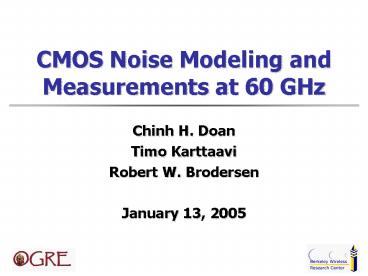CMOS Noise Modeling and Measurements at 60 GHz - PowerPoint PPT Presentation
1 / 22
Title:
CMOS Noise Modeling and Measurements at 60 GHz
Description:
... and Measurements at 60 GHz. Chinh H. Doan. Timo Karttaavi. Robert W. Brodersen. January 13, 2005. Outline ... Holistic noise model for short-channel and ... – PowerPoint PPT presentation
Number of Views:56
Avg rating:3.0/5.0
Title: CMOS Noise Modeling and Measurements at 60 GHz
1
CMOS Noise Modeling and Measurements at 60 GHz
- Chinh H. Doan
- Timo Karttaavi
- Robert W. Brodersen
- January 13, 2005
2
Outline
- Review of millimeter-wave noise models
- Physics-based compact models
- Measurement-based empirical models
- Small-signal equivalent-circuit models
- Millimeter-wave noise measurements
- Noise parameter (variable ZS)
- Lossy pad de-embedding
- Simulated and measured results
- Individual CMOS transistors
- 60-GHz amplifier circuit
3
RF Noise Model (van der Ziel)
- Short-channel drain current noise
- Induced gate noise
- Partial correlation due to NQS
- Flicker noise negligible at RF
4
Compact Noise Models
BSIM4
Philips MOS Model 11
- Holistic noise model for short-channel and
velocity saturation effects - Noise partitioning for correlated gate noise
- Channel segmentation
- Automatically includes induced gate noise,
partial correlation, NQS resistance
5
Measurement-Based Noise Models
- Fixed bias point and frequency
- Two external correlated noise sources
- Two-port modeled as noiseless
- Represented with four real parameters (Fmin,
Zopt, Rn)
6
Equivalent-Circuit Noise Models
PRC
Pospieszalski
- Uncorrelated gate noise voltage and drain noise
current - NQS resistance contributes thermal noise at
ambient temperature - One independent variable
- Essentially equivalent to van der Ziel model
- Extract P, R, C from measurements
7
Extended Transistor Noise Modeling
Pospieszalski noise model used for intrinsic
device
- Lumped, frequency-independent parasitic model
- RG and rnqs thermal noise for gate resistance and
induced gate noise (not correlated to drain
noise) - Excess short-channel drain noise current (gamma
1.4)
8
50-75 GHz Noise Parameters (VTT)
- 50-75 GHz noise parameter characterization (Fmin,
Zopt, Rn) - VTT measuring noise parameters for BWRC 130-nm
CMOS devices (individual transistors, cascodes,
etc.)
9
Test Structures and Pad De-embedding
80x1/0.13 NMOS
- Test structures
- Calibration structures (Open, short, through)
- NMOS 40x1, 60x1, 80x1, 100x1, 80x1_Ldeg, Cascode
80x1 - Bias settings (IDS/W 50, 100, 150, 200, 250
uA/um) - Pad de-embedding Hillbrand76
- Pads are passive, reciprocal network
- Noise correlation matrices
- De-embed cascaded noisy two-ports
10
40x1 Noise Params (IDS100uA/um)
11
40x1 Noise Params (IDS 150uA/um)
12
60x1 Noise Params (IDS 100uA/um)
13
60x1 Noise Params (IDS 150uA/um)
14
80x1 Noise Params (IDS 100uA/um)
15
80x1 Noise Params (IDS 150uA/um)
16
80x1 Noise Params (IDS 200uA/um)
Fitting not as good
17
80x1 Cascode Noise Params (IDS 150uA/um)
18
60-GHz Amplifier Schematic
- 3-stage cascode amplifier design
- Cascode transistors improve isolation, stability
- Input/output matching networks designed to match
50 O - Pads are included as part of amplifier
- Designed using only measured components
19
50-75 GHz Noise Figure (Agilent)
Agilent 8973A Noise Figure Analyzer
V-band Noise Source
Isolator
Waveguide Probes
OML Mixer
20
60-GHz Amplifier Noise Figure
21
Conclusions
- Pospieszalski intrinsic noise model
- Increased channel current noise (gamma 1.4)
- RG and rnqs for gate resistance and induced gate
noise (uncorrelated to drain noise) - VTT noise parameter device characterization
- Accurate prediction of Zopt
- Fmin within about 0.5 dB
- Agilent circuit NF characterization of 60-GHz
amplifier - Models provide good circuit NF prediction
- Remaining issues
- Phase error in Zopt Probe placement? Correlated
noise? More sophistacated noise model? - Comparison to compact models?
22
Acknowledgments
- VTT Millilab
- H. Tran and K. Fujii, Agilent Technologies
- DARPA TEAM project
- STMicroelectronics































